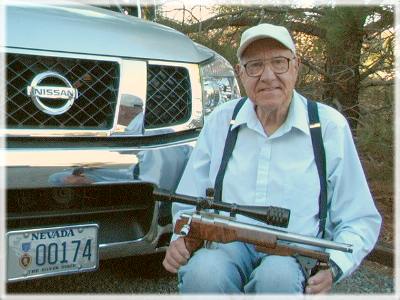Vern S. Juenke
Vern invented and introduced the ICC or 'Vern Juenke Machine'

The following is a short history of the background that has given me the knowledge and incentive to design and build the I.C.C. unit.
As a young teenager I had always been interested in guns that shoot accurately. I had the good fortune to attend a government approved training school that featured machine shop training, metallurgy and heat treating. This was a 1200 hour course called the 'Smith Hughes'. It was now my time to go to war. I shot 'Expert' rifleman in my infantry training with the M1 Garand rifle and shipped out to Germany and joined General Patton's 94th infantry division. We were assigned to take all of the ground back that the Germans took during the Battle of the Bulge. I was wounded in action during a combat patrol to secure a small pine forest. I was flown to the 48th general hospital in Paris. My wound was not life threatening but very painful. I spent five weeks there with about two weeks of that in a wheel chair. I did a lot of thinking of what I wanted to do after I left the army. This was the first time that I thought I would really make it back alive. Using my knowledge of what I learned in school, I thought I would like to become a gunsmith.
My brother, Arnold, was starting a gun shop and sporting goods store in Santa Monica, CA. So when I finally got home after 18 months 'over there' , I went to work as the metal working person. At this time there was a lot of development work going on to improve many factory cartridges. I made several chambering reamers and I came up with some of the Saturn I.C.L. line of wildcats. We made custom rifles for several famous people, some of which included Gary Cooper, Noah Dietrich of Hughes tool, Wilbur May of the May Company and Jerry Orbach of Orbach's department store. We had national recognition with the American Rifleman Magazine. During this time I got interested in radio controlled model airplanes. I designed and built many multi-channel control systems before the days of digital proportional. We moved the gun shop to Reno, NV in 1954. Gary Cooper came up right after he finished the High Noon movie to pick up his rifle. I met and shook hands with the legend. He was a great person in real life.
I went to work for Nevada Air Products in 1956 in the R & D department. We were doing some work for Sperry Utah on parts for the Sergeant missile program. I went to Salt Lake and took their required week-long class on Reliable Solder Connections. NAPCO was also making dive brake units for navy aircraft. We got a contract from Westinghouse to design and build a new style navy antenna tuner for navy ships. This tuner had a long silver wire coil encased in a nitrogen tank unit. A motor driven shorting ring would move up and down this coil to tune the antenna to the various radio frequencies the navy wanted to transmit on. This motor driven shorting ring had two speeds of travel, a 1: 1 ratio and a 8.5:1 ratio. This 8.5:1 ratio was required to fine-tune the unit. I designed and got a patent on a ball planetary reduction unit that would shift from the 1:1 ratio to the 8.5:1 ratio merely by energizing a 24 VDC magnetic coil. We had navy inspectors at our plant and they really liked my unit. The first nuclear submarine had our new tuner and every time they would transmit on their sub, my unit would do their tuning operation. Later on at NAPCO, I designed and built an all-electronic slot machine with no moving parts except in the coin acceptor and payout hopper. This was a first in the gaming industry. The basic configuration and circuitry used on this unit to count the coins as they were paid out was the basis of my bullet and case metal mass detector.
After I left NAPCO I went to work for a company that distributed and operated slot machines. I did a lot of electronic design that they used in their machines. I also designed some electronic horse-race games that they used in their business.
I left this company and moved out into the county west of Reno. I got my FFL and business license so I could do gunsmithing on a full time basis at home. When the Metallic Handgun Silhouette shooting became a real popular sport, I designed and modified the T.C. Contender frame and with bench-rest barrels, this became just as accurate as an XP/100 bolt gun and was easier to shoot.
I got married in 1948 to Irma. We have 4 children, 6 grandchildren, and 3 great grand children. Without Irma's help, encouragement and understanding, there would not have been an I.C.C. unit. We have made over 700 at last count and sell them on a worldwide market.
V. S. Juenke